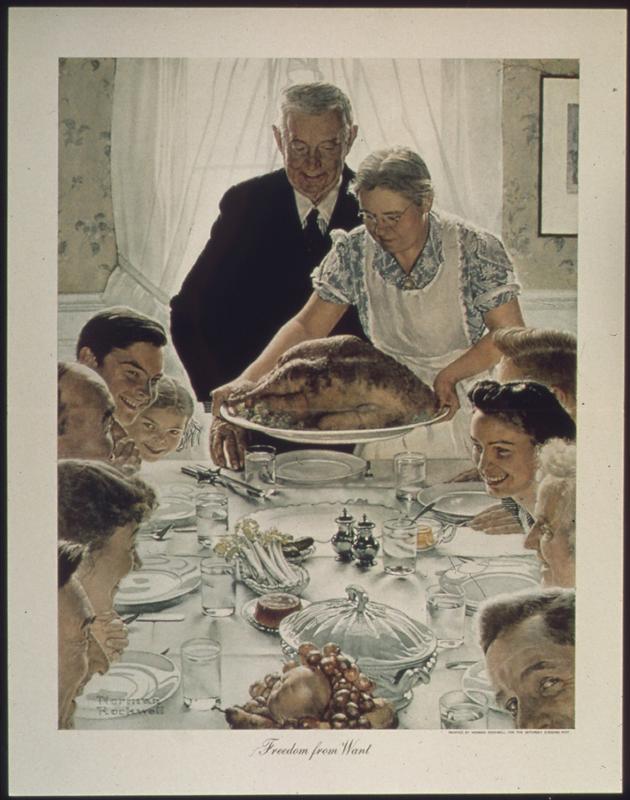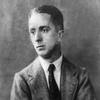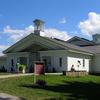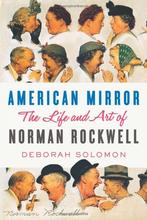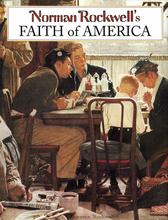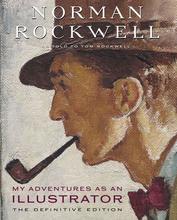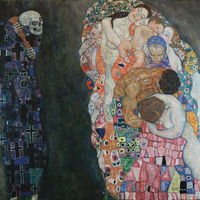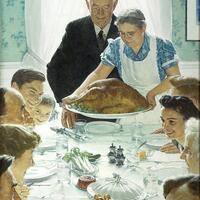More about Freedom from Want
- All
- Info
- Shop

Sr. Contributor
Who needs stuff or for that matter, wants, when you’ve turkey and celery?
Freedom From Want is the third, and perhaps most prominent image, in Norman Rockwell’s series of paintings the Four Freedoms. It depicts three generations partaking in a Thanksgiving meal, and is often interpreted as a symbol of the American ideal of a white, middle-class, nuclear family.
Rockwell was often written off by critics as a simple illustrator, a title less prestigious than painter. This work, though described by Rockwell as the easiest in the series to execute, was noted for its technical mastery. Likened to an American Last Supper, a topic oft-painted by artists from Leonardo da Vinci to Emil Nolde, there are implicit ties between religious and patriotic values. This is also echoed in the painting’s perspective, which recalls Tintoretto’s rendition of the Last Supper, replacing the chalice and bread, a reference to the eucharist, with a turkey. Rockwell demonstrates his skills through the white-on-white painting, another trope in art history, of the white plates on white tablecloth, echoing Whistler’s Symphony in White and Malevich’s White on White.
This painting is Rockwell’s personal interpretation of freedom of want, a scene of a real shared meal painted from models of his own chosen family in his living room. Contemporary criticism of Rockwell’s work often points to the narrow representations that were present in his paintings, which excluded many Americans. However, this painting is actually a departure from the narrative that Rockwell’s work has come to represent, representing a modern concept of chosen family made up of family and friends. The models he used for this painting exemplified his understanding of chosen family, consisting of his family, friends, and neighbors. The central figure, the matriarch presenting the turkey, was the Rockwells’ cook, Mrs. Thaddeus Wheaton. Clockwise from Wheaton are Lester Brush, Florence Lindsey, Rockwell’s mother Nancy, Jim Martin, Dan Walsh, his wife Mary Rockwell, Charles Lindsey, and the Hoisington children, Bill and Shirley. Martin appeared in every painting in this series, and can be found in the lower right corner of Freedom of Speech, the center of Freedom of Worship, and as the patriarch in Freedom from Fear. Rockwell was also well acquainted with the turkey, saying, “Our cook cooked it, I painted it and we ate it. That was one of the few times I’ve ever eaten the model.”
Though it is a whitewashed image of America, its historical and ideological significance has made it a canonical image of American traditions and widely reinterpreted in popular culture. It has been featured in films and television including in "Lilo and Stitch," "Modern Family," "The Simpsons," and "The Muppets." It has been quoted in contemporary art works like artist and AIDS activist Frank Moore’s Freedom to Share, which replaces the turkey with syringes and pills and features more diverse subjects, to represent issues of the health crisis.
Each of the paintings in the Freedom series were all accompanied by essays written by prominent American thinkers. Freedom from Want was accompanied by an essay of the same name by novelist and poet Carlos Bulosan. Bulosan’s essay set itself apart from the others in the series, which focused on the issues abroad and the spread of American ideals, by focusing on domestic issues. In his essay, Bulosan writes of democracy, which frees us from want, tying wants to the hardships of American workers. For Rockwell, freedom from want is not the ability to satisfy every desire, but rather the freedom from desire. 1943 was in the middle of the Second World War, and even this modest meal would have been a far cry from the reality of the average American. This painting was meant to be a hopeful depiction of FDR’s America, a post-war image of abundance. However, it is not a picture of the behemoth meat feast accompanied by carbohydrates and casseroles that Americans may picture today when thinking about a Thanksgiving meal. The meal presented in his painting, though abundant, is not extravagant. The glasses are filled with water, not wine, and the turkey is accompanied simply by cranberry sauce, celery, and an unspecified covered casserole. It is an image of a contented family with enough to eat, sharing each other’s company.
Like Rockwell, Bulosan describes freedom not as abundance but as being a part of democracy, saying, “To us, freedom is not an intangible thing. When we have enough to eat, then we are healthy enough to enjoy what we eat. Then we have the time and ability to read and think and discuss things. Then we are not merely living but also becoming a creative part of life. It is only then that we become a growing part of democracy.”
Sources
- Anapur, Eli. “The American Spirit of Norman Rockwell’s Thanksgiving Painting.” Widewalls. Nov 24, 2016. https://www.widewalls.ch/magazine/norman-rockwell-thanksgiving.
- Bendiner, Kenneth. Food in Painting: From Renaissance to Present (London: Reaktion Books, 2004).
- Bulosan, Carlos. “Freedom From Want.” Saturday Evening Post. December 21, 2017, originally published in 1943. https://www.saturdayeveningpost.com/2017/12/carlos-bulosans-freedom-wan….
- Duggan, Bob. “What is Norman Rockwell’s Thanksgiving Picture Really About?” Big Think. Nov 27, 2013. https://bigthink.com/Picture-This/what-norman-rockwells-thanksgiving-pi….
- Koerselman, Rebecca. “Life, Rockwell, and Radio:exploring religious iconography in America, 1944-1950 (2007).” Retrospective Theses and Dissertations. 14539. https://lib.dr.iastate.edu/rtd/14539.
- McCormick, Jennifer. “Storeroom Stories: Freedom from Want.” Charleston Museum. Accessed August 24, 2020. https://www.mfah.org/blogs/inside-mfah/norman-rockwells-four-freedoms.
- Smith, Megan. “Norman Rockwell’s ‘Four Freedoms’.” The Museum of Fine Arts, Houston. Dec 16, 2019. Accessed August 24, 2020. https://www.mfah.org/blogs/inside-mfah/norman-rockwells-four-freedoms.
Featured Content
Here is what Wikipedia says about Freedom from Want
Freedom from Want, also known as The Thanksgiving Picture or I'll Be Home for Christmas, is the third of the Four Freedoms, a series of four oil paintings by American artist Norman Rockwell. The paintings were inspired by the Four Freedoms, a set of four goals articulated by Franklin D. Roosevelt, the president of the United States, in his 1941 State of the Union address.
Freedom from Want was painted in November 1942 and published in the March 6, 1943, issue of The Saturday Evening Post. All of the people in the picture were friends and family of Rockwell in Arlington, Vermont, who were photographed individually and painted into the scene. The work depicts a group of people gathered around a dinner table for a holiday meal. Having been partially created on Thanksgiving to depict the celebration, it has become an iconic representation for Americans of Thanksgiving and family holiday gatherings in general. The Post published Freedom from Want with a corresponding essay by Carlos Bulosan as part of the Four Freedoms series. Despite many who endured sociopolitical hardships abroad, Bulosan's essay spoke on behalf of those enduring the socioeconomic hardships domestically, and it thrust him into prominence.
The painting has had a wide array of adaptations, parodies, and other uses, such as for the cover for the 1946 book Norman Rockwell, Illustrator. Although the image was popular at the time in the United States and remains so, it caused resentment in Europe where the masses were enduring wartime hardship. Artistically, the work is highly regarded as an example of mastery of the challenges of white-on-white painting and as one of Rockwell's most famous works.
Check out the full Wikipedia article about Freedom from Want

